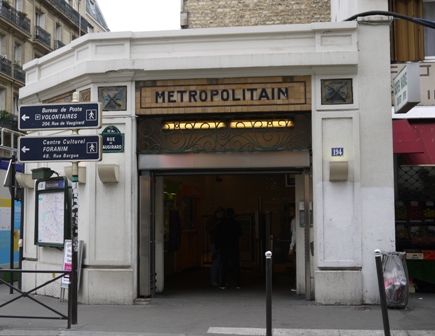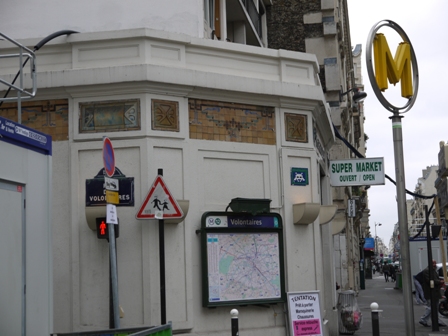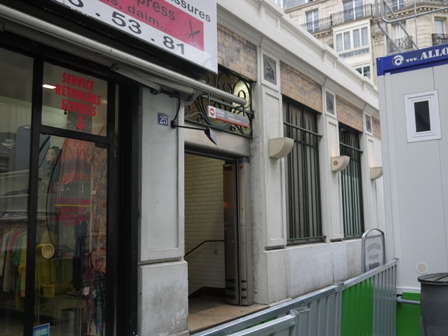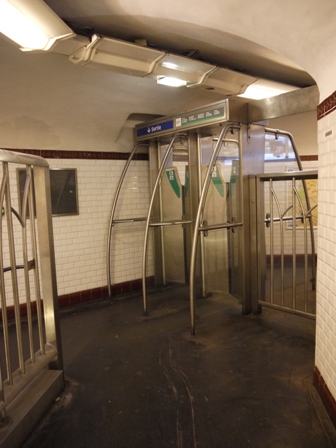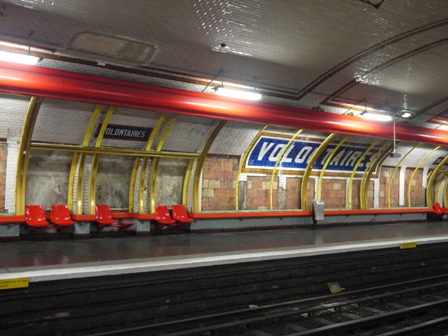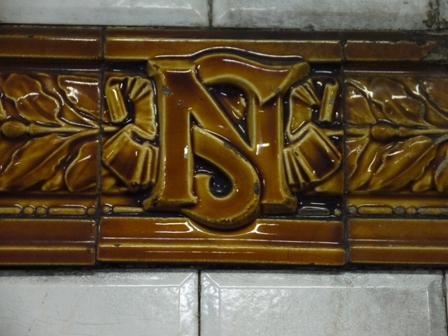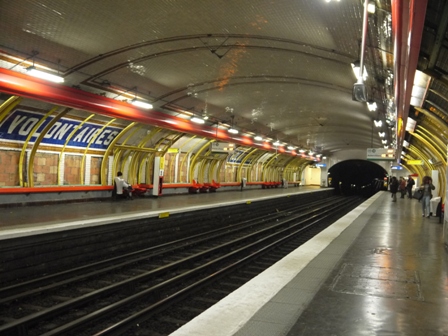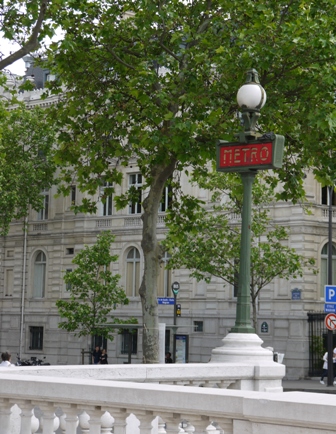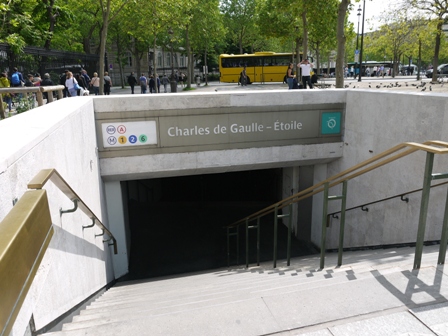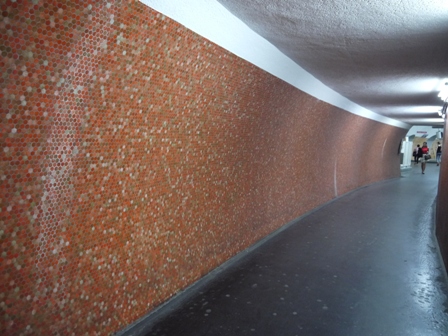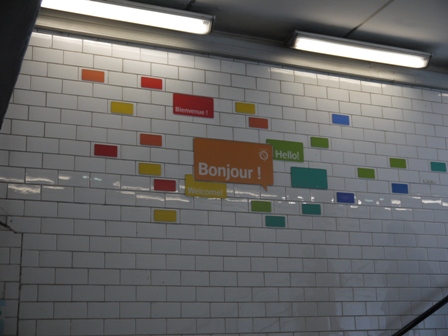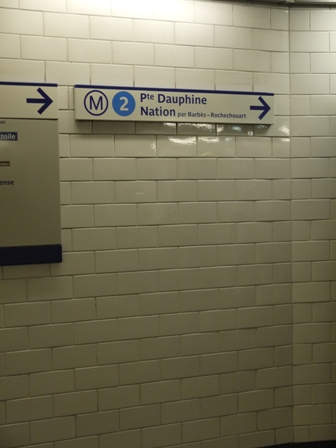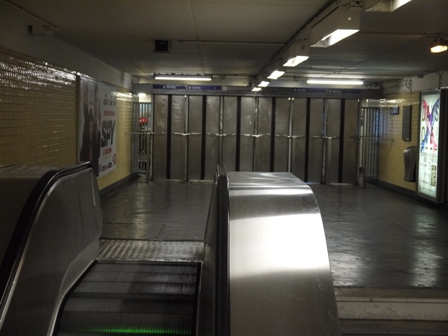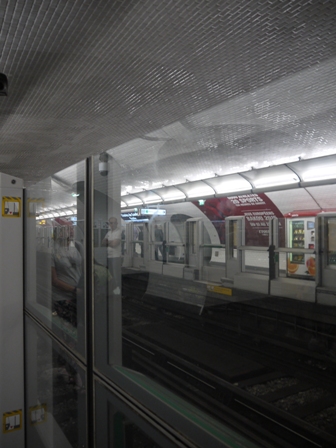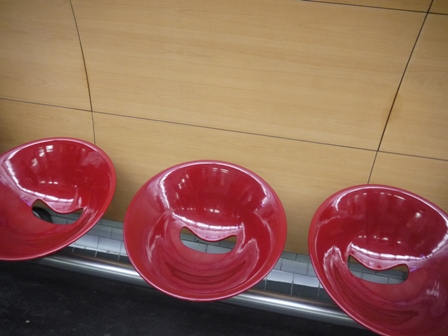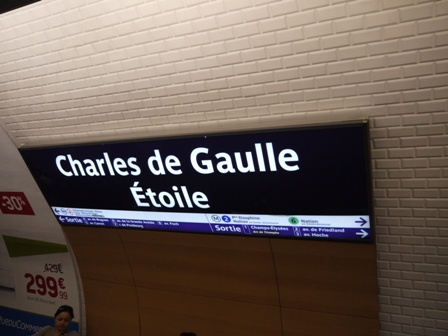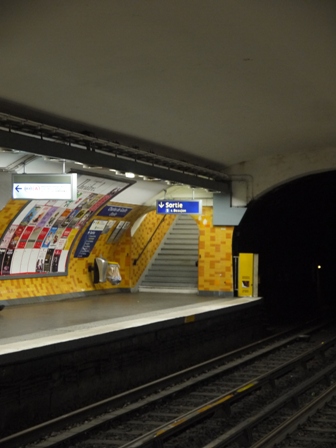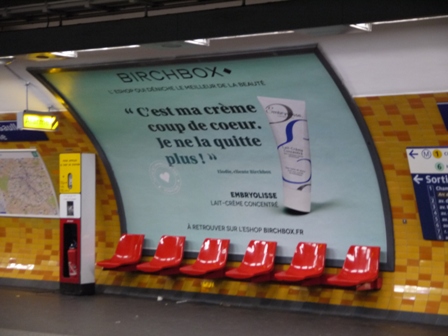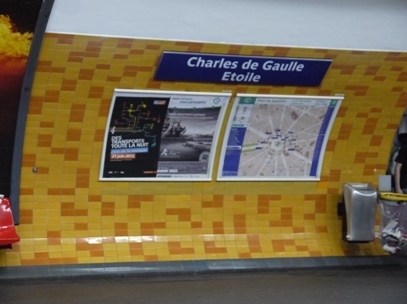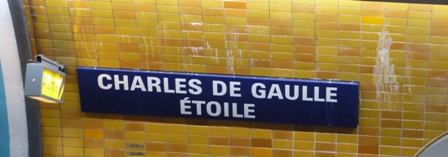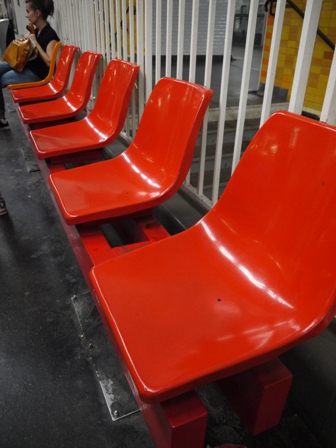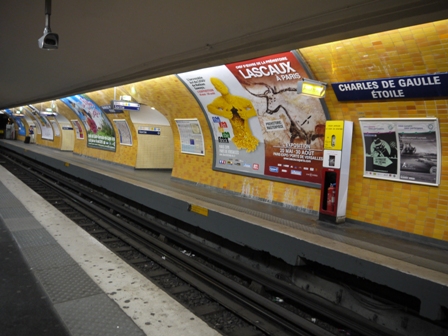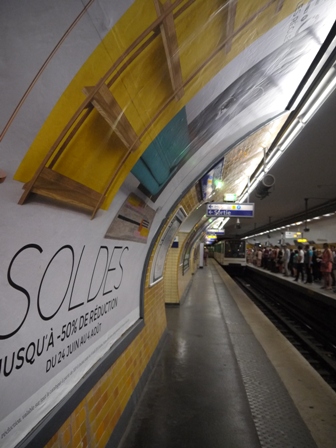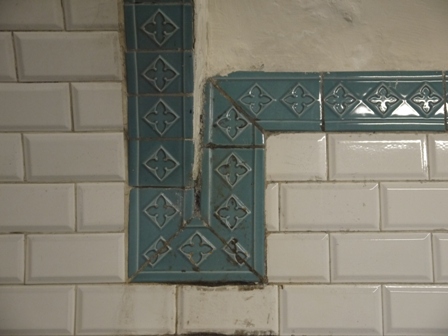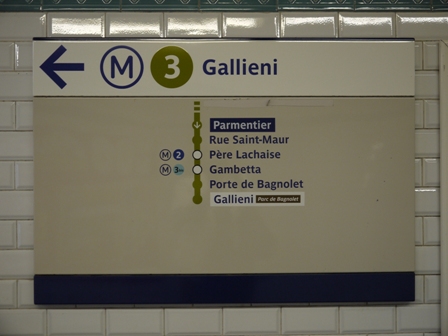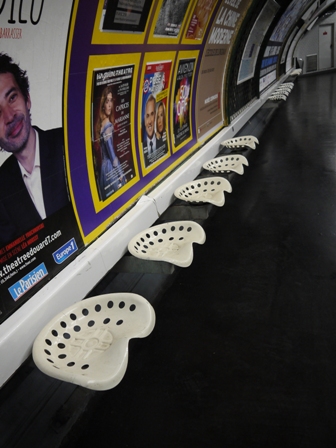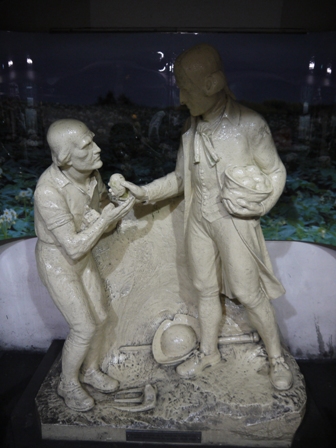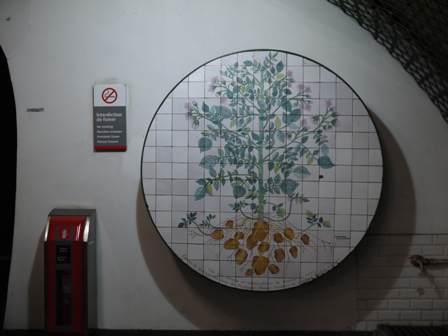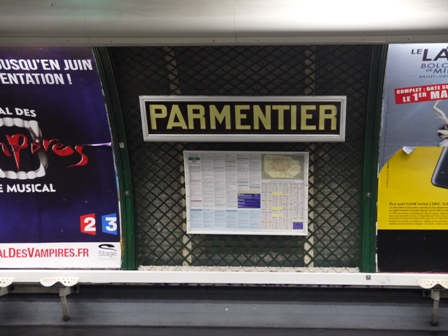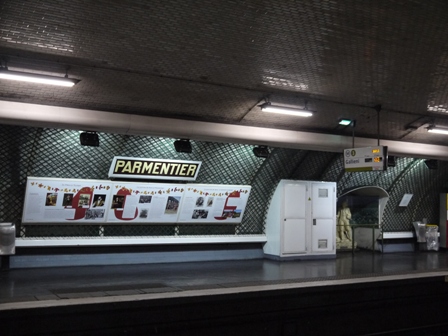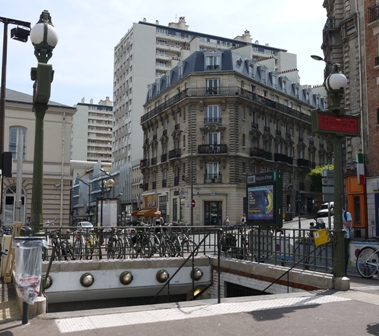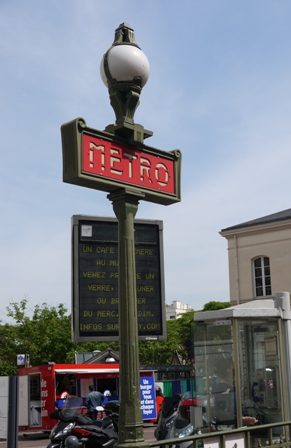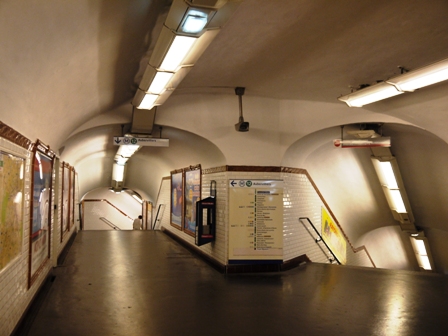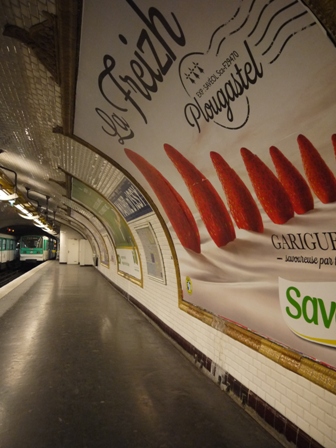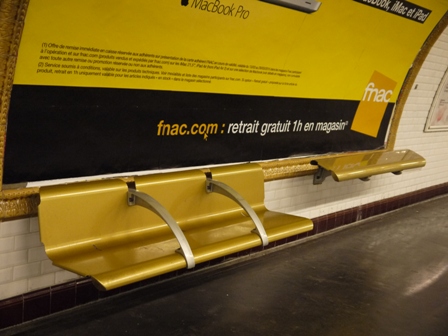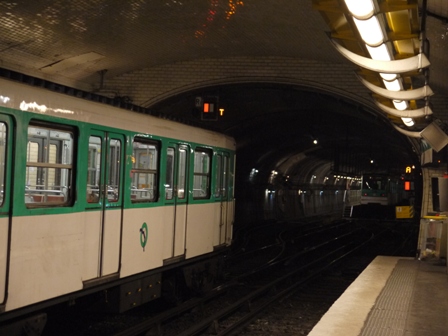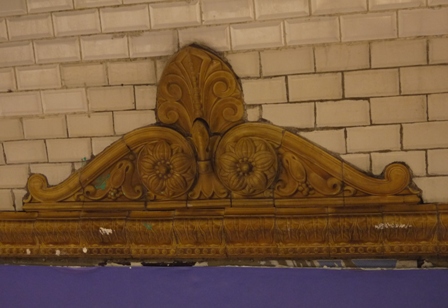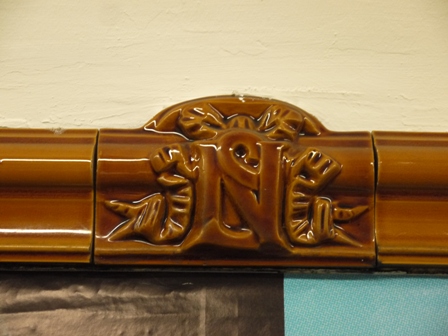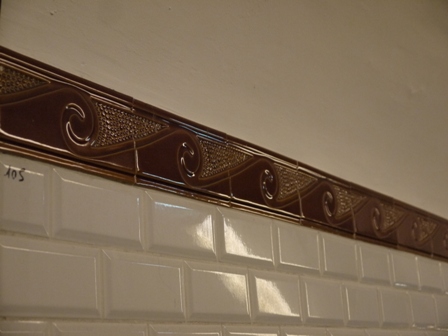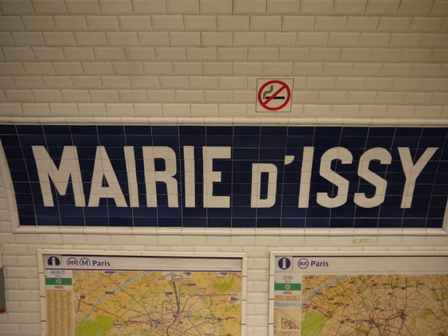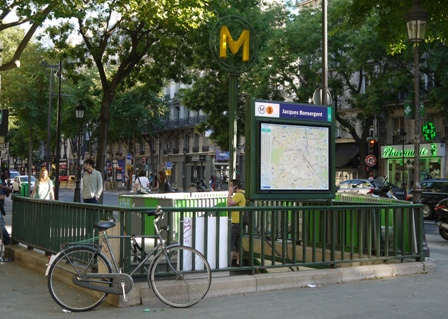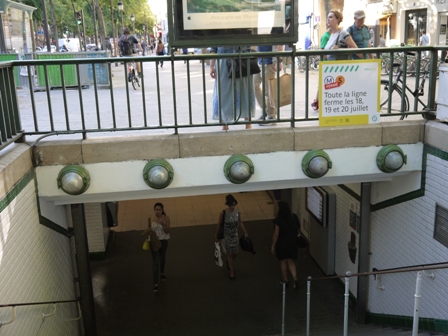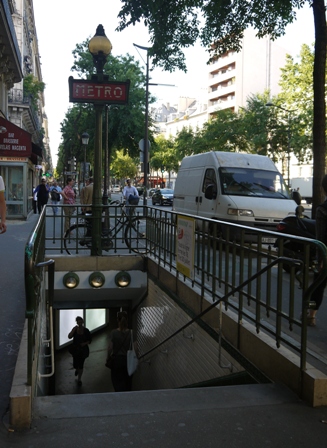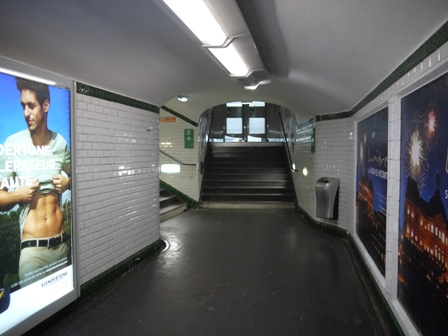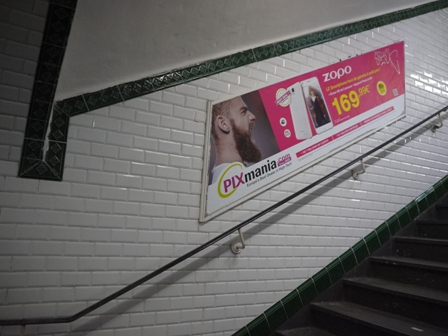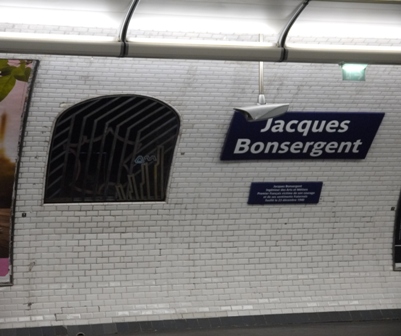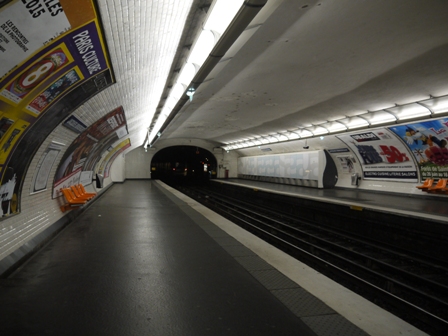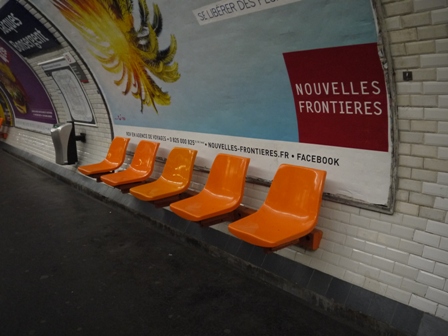- Details
The station opened on 5 November 1910.
It is situated in the 15th arrondissement on the crossroad of rue Vaugirard and rue Volontaires (road of the volunteers - named after the soldiers of the the French Revolution).
It was built as a station of the line A of the North-South company is now served by the metro line 12.
The white corner building has an entrance on the rue Vaugirard. It can be closed by Rolladen shutters. The window above the Rollladen is covered with some curved wrought-iron.
The letters of the Metropolitain sign have created in 3D ceramic tiles and painted in black. They are surrounded by light brown tiles with a black line to frame the word Metropolitain.
Two square blue and brown large ceramic tiles with Art Nouveau design have been placed on either side of the sign.
The wall on the corner has been cut off to give more space on the pavement and make it easier to go round the corner.
The station signage and a map of the metro network are fixed to the wall in a green frame with light.
Above it is a panel with light brown ceramic tiles and a flower garland stencilled on it. On either side is a square brown and blue ceramic tile.
A little blue space invader mosaic has has been added by a street artist.
A stainless steel pole with a yellow letter M in a circle has been positioned close by to see the entrance from further away. The M is lit during darkness.
Exit on the rue Volontaires from the outside. The exit is around the corner from the entrance, keeping passengers entering and exiting well apart and so allowing a larger number of travellers.
The exit is narrower than the entry, but it has the same wrought-iron work above. It can be shut by metal folding shutters. The panels of ceramic tiles with flower gralands and the square tiles continue on this side of the building.
A small sign in French, English and Spanish informs that there is no entry.
Should anybody enter nevertheless and walk down the stairs, they come to the exit barrier. The metal swing doors only allow to exit.
The walls of the corridor are tiled in white with a brown border.
A renovation program has been started for several months.
The walls of the station have been stripped back to the brick revealing the old signage. Large white uppercase letters have been painted on blue ceramic tiles and surrounded by a white line and a light brown frame.
During renovation work in previous years, metal frames and red lights have been added.
The red plastic seats are fixed on the walls of recesses.
The vaulted ceiling is tiled in white, but has brown frames.
Brown North-South logo and olive branches on ceramic tiles on an advertising frame.
The logo consists of the letters S and N intertwined on a ribbon.
The two side platforms of the line. The edge of the platform is marked in white, with no additional yellow line.
A row of about 20 cm wide nobbed tiles has been added to warn sight-impaired travellers of the edge. The rest of the ground has been painted grey.
- Details
The underground station opened on 1 September 1900 with the opening of the line 1. It is served today by the metro lines 1, 2 and 6.
It is situated at the intersection of the 8th, 16th and 17th arrondissements. The station serves the top of the Champs Élysées and the Arc de Triomphe, which is located in the centre of a large roundabout.
The station was originally named Étoile. It changed its name on 21 February 1970 when the square under which it lies changed its name. The station takes its name from the former president of France - Charles de Gaulle (1890 - 1970), who died later that year. Étoile means Star in French.
The balustrade of this entrance is made of light-coloured stone with rounded 'bars', similar to those on pont Alexandre III.
On the pillars on the top of the entrance is a green lamppost with a white round light at the top. The letters METRO are carved from red glass and placed in a green frame that is integrated in the lamppost. Behind the red glass is white glass.
This entrance is surrounded by white stone walls.
On the walls, as well as in the centre of the stairs are gold coloured handrails.
The station sign is integrated in the wall above the entrance. It shows the train line A and the three metro lines 1, 2, and 6. In the centre is the name Charles de Gaulle - Étoile, and to the right of it the logo of the RATP.
The walls in the corridor are curved. They are covered in thousands of small hexagonal tiles in brown tones.
The top few centimetres and the flat ceiling are painted white.
The ground is painted grey.
The walls in this corridor have been tiled in flat white rectangular tiles.
The walls have been decorated with coloured signs in English and French saying "Hello" and "Welcome" and some smaller plain coloured plastic rectangles.
Direction sign to the line 2 in corridor. Both the lines 6 and 2 have Nation as a terminal; so the sign clarifies that the line 2 goes via Barbès - Rochechouart.
Exit from the station. Four solid metal swing doors are fixed at the end wall. The doors swing open in the middle when a pressure pad on the ground is pressed.
The walls have been tiled in small square pale yellow ceramic tiles. The tiles have a diagonal cross pattern.
Lights are fixed on the the ceiling in several rectangular boxes.
An escalator has been installed next to the stairs.
Platform Line 1
Line 1 started operation on 1 September 1900. The line is now fully automated.
As a result, platform-edge doors have been installed on the line.
The platforms are side platforms.
The vaulted ceiling is tiled.
The light are set in metal frame along the platform edge. They uplight and reflect on the top of the metal.
The red metal seats are fixed on a silver metal bar to the the bottom to the wall. They are half-bowl shaped with a smilie slit.
The signage, directions to the exits and connecting lines and a wooden panel form one unit and are placed behind some seats.
The walls are tiled in "Metro Style", that is small rectangular ceramic tiles with a raised centre.
Platform Line 2
Line 2 started operation on 13 December 1900.
Entrance to the platform is from the end. The tracks are between the platforms.
The vaulted ceiling is painted white.
The edge of the platform is marked in white, with no additional yellow line. A row of about 20 cm wide nobbed tiles has been added to warn sight-impaired travellers of the edge.
The red plastic seats are fixed to the wall with a bar. The advertising board behind it is in a metal frame.
The walls are tiled in light and dark orange rectangular ceramic tiles.
The signage on platform is in mixed case with white letters on a dark blue background. Underneath it are two white frames with information of the transport arrangements for the night of the 21 June (Night of the music - nuit de la musique) and a map of the local area.
Platform Line 6
Line 5 started operation on 2 October 1900 as part of the line 2 Sud. On 14 October 1907 it became part of the line 5 before being transferred to the line 6 on 6 October 1942.
The signage on line 6 is in all uppercase white letters on a blue plasticised sign without frame.
The walls are tiles in rectangular tiles in different shades of yellow.
A row of red plastic chairs has been attached to a red metal bar fixed to the ground in front of the white fence, which separates the stairs from the platform.
The narrow platforms are on either side of a single track.
The edges are painted white, followed by a row of plastic tiles with raised circles.
Charles de Gaulle - Étoile is a terminal for the line 6. The platforms are very narrow. Therefore when the metro arrives, it opens the doors on the exit side only. Once the carriages are empty, those doors shut and the doors to the other side open allowing waiting passengers to enter.
The platforms holds less people than would fit in the empty carriages, which is a problem, when there are delays.
- Details
The underground station Parmentier opened on 19 October 1904.
It is situated in the 11th arrondissement.
It is served by the metro line 3. The station takes its name after Antoine Parmentier (1737 - 1813), who, when looking for new vegetables to include in the French diet, introduced the potato. The station is decorated with items related to Parmentier and potatoes.
The walls are tiled with white ceramic tiles known as Metro; the centre part is raised and allows light to be reflected easily. After all the metro was built at the beginning of the 20th century, when normal lights were fuelled by kerosene or gas.
The ceramic frieze is in light turquoise with flowers in diamonds.
Display at the entrance to the platform to indicate the direction of the metro (Gallieni), the stations inbetween and their link with other metros.
There are no connections to other metro lines from Parmentier.
Platform Line 3
In keeping up with the theme of the station, the seats are white, metal tractor seats on a white bar.
The walls are curved and covered in advertising posters.
The floor is painted grey.
White statue of Antoine Parmentier giving a farmer some potaoes to plant. While the potato was already used in other parts of Europe, it was not part of the French diet at that time.
Painted potato plant and potatoes on round panel composed of small square tiles. It is places at the end of the platform.
Part of the wall is covered with a green trellis. A sign with the station name has been attached to it. The name is printed in yellow uppercase on a black background. The sign is in a white frame.
Underneath it is a noticeboard with the general transportation regulations and a map of the tarification zones.
Platform in direction Gallieni with the statue of Parmentier and a large display showing the history of the potato. The wall is covered in a green trellis.
Square spot light up the walls. Additionally, short light tubes in a basic metal frame have been placed in intervalls along the ceiling.
The ceiling is vaulted and tiled.
The edge of the platforms is painted white and has also a grey row of knobbed tiles.
- Details
The station Marie d'Issy opened on 24 March 1934.
It serves the community of Issy-les-Moulineaux. It is the southern terminus of the line 12. It is an underground station.
The station only has one entrance, which leads to the market place in front of the town hall ( = mairie in French).
Two Derveux posts have been place at the entrance
The banister around the entrance is green with metal bars of different lengths.
The station sign is at the side of the banister.
The station has one additional exit for an escalator a little further on the place.
Dervaud post with round white light.
Entrance to the platform in direction Corentin Celton is on the left. The sign on the small wall has the list of all stations on this line and a little arrow pointing left.
The right corridor is one the exits from the platform.
The walls are tiled halfway up.and topped with brown border tilles. Brown signifies that there are not metro correspondences at this station.
The ceiling is painted white.
Passengers have to leave the carriages when arriving at the terminus while the train drives into the tunnel and changes direction. Therefore, there are no seating facilities on this platform.
The advertising boards are framed in light brown ceramic tiles with plants and topped with mustard coloured flowers.
The border tiles at the bottom are chocolate brown.
Golden bench with dividers and a lean on bench on the northbound platform of the terminus.
Metro waiting on the platform for passengers and ranging area in the tunnel. Passengers are not allowed in this area.
The edge of the platfrom is painted white and marked with nobbed tiles.
The yellow lights in the Ouï-dire style are fixed to the ceiling by silver scythe brackets.
The vaulted ceiling is tiled.
Mustard coloured flower decoration above one of the ceramic panels.
The geometric shapes have been created separately and assembled above each of the advertising frames.
The glazed ceramic North/South logo on one of the ceramic tiles.
The letters N and S are intertwined, and decorated with a ribbon.
The other tiles of the frames don't have any pattern.
Dark brown ceramic tiles with waves in the corridor to the platforms.
The waves are smooth, the space above has a dotted pattern.
The white tiles below are in the "Metro" style.
Signage of Mairie d'Issy printed on blue tiles with a white ceramic frame.
The large white uppercase letters are 6 tiles high.
A small sign above it reminds passengers that smoking is not permitted on the platforms.
- Details
The station opened on 17 December 1906 under the name of Lancry and was one of the terminals until the line was extended until Gare du Nord in November 1907.
On 10 February 1946, the station was renamed to commemorate Jacques Bonsergent, an Engineer at the nearby Arts et Métiers School, who was the first Frenchman to be executed on 23 December 1940 by firing squad during the German occupation.
The station is situated in the 10th arrondissement. It is served by the metro line 5. It is an underground station.
The main entrance is surrounded by a plain green fence with bars, which have all the same length.
The metro sign is a large yellow M in a double circle mounted on a steel pole. They were intoduced in the 70s.
The station sign is al large square green box. On pavement side a metro map of Paris is shown under the station name and Metro line number.
Five round lamps are placed over the entrance.
Handrails have been fixed to the white, tiled walls.
An additional handrail is in the middle of the stairs.
The smaller side entrance has a green fence with bars of different heights. It is signalled by a Dervaux post.
The word METRO is cut out of red plastic, showing the letters in white, and placed in a green frame on the post.
A white ball-shaped light is on top of it.
Three round lamps are fixed to the ceiling of the entrance at street-level.
Corridor from the platform. The walls are tiled to the ceiling. Advertising has been placed in white ceramic frames.
Other advertising has been placed in lit frames with a roll of posters that change every few seconds.
The walls are tiled with white ceramic tiles with a raised centre and topped with a row of green border tiles with a geometric flower pattern.
The walls are tiled and bordered with a row of tiles with green flowers. Narrow advertising panels have been placed between it and the handrail.
The row closest to the stairs is plain green.
The signage is in mixed case white letters on a blue sign. Underneath it is a blue sign with the inscription "Jacques Bonsergent - Ingénieur des Arts et Métiers - Premier francais victime de son courage et de ses sentiments fraternels - fusillé le 23 décembre 1940". The vent next to it has a map of France worked in metal.
The platforms are on either side of the tracks. The edge of the platforms is marked with a broad white line and a row of rubber tiles with raised circles to help visually impaired passengers.
The slightly vaulted ceiling is painted. The walls are tiled in white.
The lights are uplighting, reflecting in the metal of the light-covers.
A row of orange plastic seats has been fixed to the wall with an orange metal bar. They are placed in front of an advertising panel, which has a metal frame.

